28 December 2018 (13:40): IEEE AP/MTT/EMC/ED Turkey Seminar Series (S.43)
Speaker: Asst. Prof. Sema Dumanlı Oktar, Boğaziçi University
Topic: “Internet of Health Things (IoHT) and the Healthcare Revolution”
Location: Middle East Technical University, Ankara, Turkey
Abstract: Advances in sensing technologies, as part of the emerging era of the Internet of Things (IoT) are widely investigated as a solution to the challenges of modern healthcare. Wearable and implantable sensing technologies are valuable tools that can encourage people to monitor their own well-being and facilitate timely health interventions. Yet, the utility of wearable and implantable sensors rises when they are used alongside other healthcare systems and sensing technologies within smart environments. This talk discusses the future generation of wearable and implantable sensing devices, and their interaction with different kinds of smart things in dynamic environments such as smart home/office/factory. The focus of the talk will be reconfigurable antenna design while a brief overview of existing projects conducted in BOUNtenna will also be provided.
Bio: Sema Dumanli received the B.Sc. degree in electrical and electronic engineering from Orta Dogu Teknik Universitesi, Turkey, in 2006, and the Ph.D. degree from the University of Bristol, Bristol, U.K., in 2010. She was with Toshiba Research Europe, UK, as a Research Engineer and a Senior Research Engineer from 2010 to 2017. She is currently an Assistant Professor with Bogazici University, Turkey and serves on the Management Board of Boun LifeSci. Her current research interests include antenna element and array design for body area networks, implantable and wearable devices, eHealth, and multi-in–multi-out communications.
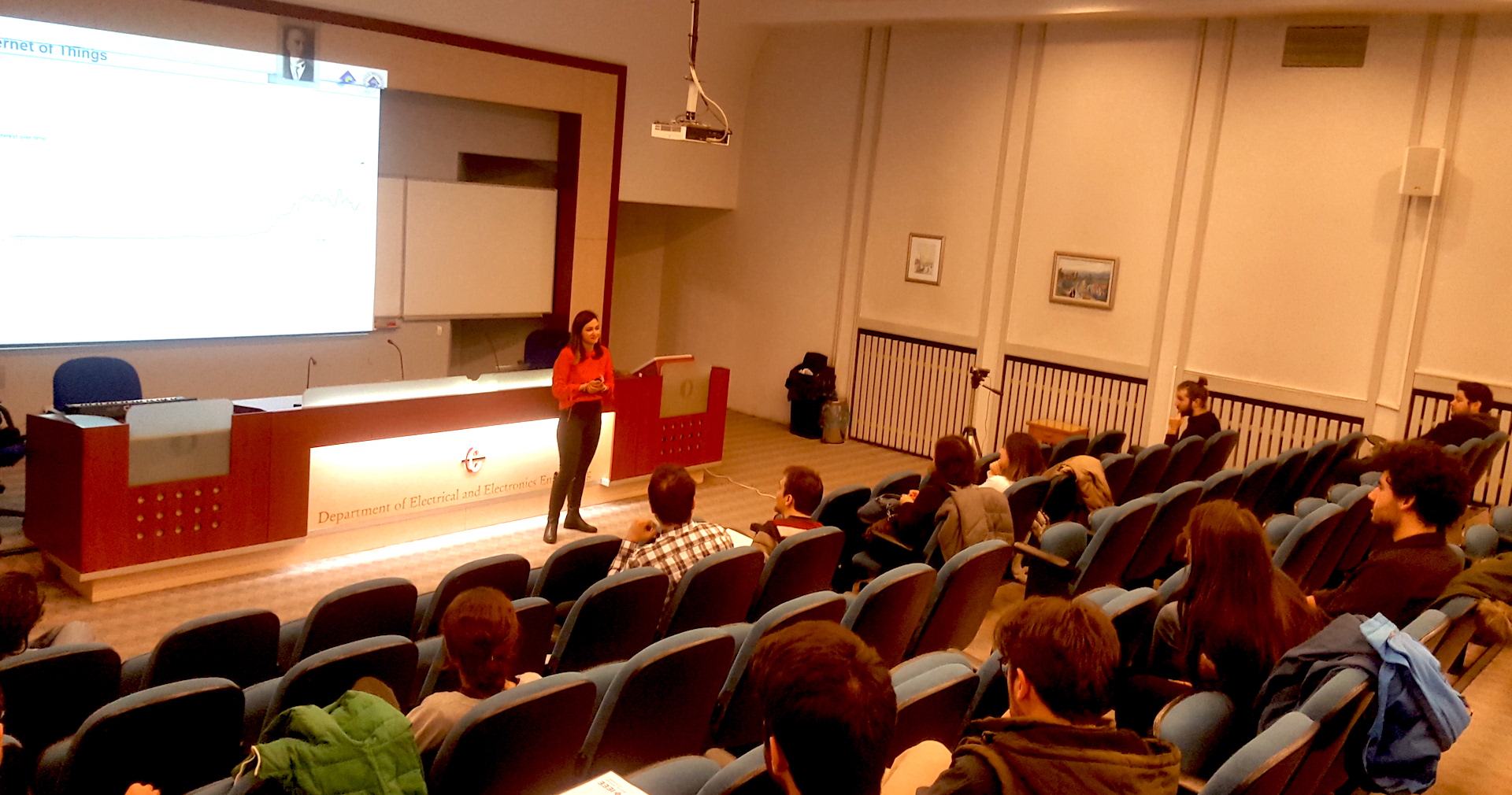
vTools Link: https://events.vtools.ieee.org/m/188798
—
14 December 2018 (13:40): IEEE AP/MTT/EMC/ED Turkey Seminar Series (S.42)
Speaker: Assoc. Prof. Alptekin Temizel, Middle East Technical University
Topic: “Deep Learning in Computer Vision”
Location: Middle East Technical University, Ankara, Turkey
Abstract: Deep Neural Networks (DNNs) have been shown to achieve human-level accuracy for many vision tasks. On the other hand, they require considerable amounts of computational power and data to train. In this talk, I will first talk about the deep learning based approaches and their differences to traditional approaches. I will then give an overview of the deep learning ecosystem (tools and systems) for training and inference. Then I will be focusing on their application to the computer vision problems with a number of examples including image classification, object detection, image segmentation as well as generative models. I will then conclude by discussing the challenges and problems in current deep learning based approaches.
Bio: Alptekin Temizel Assoc. Prof., Graduate School of Informatics, Middle East Technical University (METU) (2007-Current); B.Sc., Electrical and Electronics Engineering, METU (1999); Ph.D. Centre of Vision, Speech and Signal Processing, University of Surrey (2006). He co-founded Visioprime Ltd, UK, a company developing Intelligent Video Systems for Security, where he worked as senior research engineer in 2001-2006 and acquired a number of patents. He started as an Assistant Professor at METU in 2007 where he is currently an Associate Professor. He is the principal investigator of “GPU Education and Research Centre” and NVIDIA Deep Learning Institute (DLI) Certified Instructor and DLI University Ambassador. He was a visiting researcher at Microsoft MLDC-Lisbon in the summers of 2014 and 2015. He was on sabbatical leave at University of Birmingham, UK in 2016-2017. His main research interests are video surveillance, computer vision, machine learning, deep learning, GPU programming and CUDA.
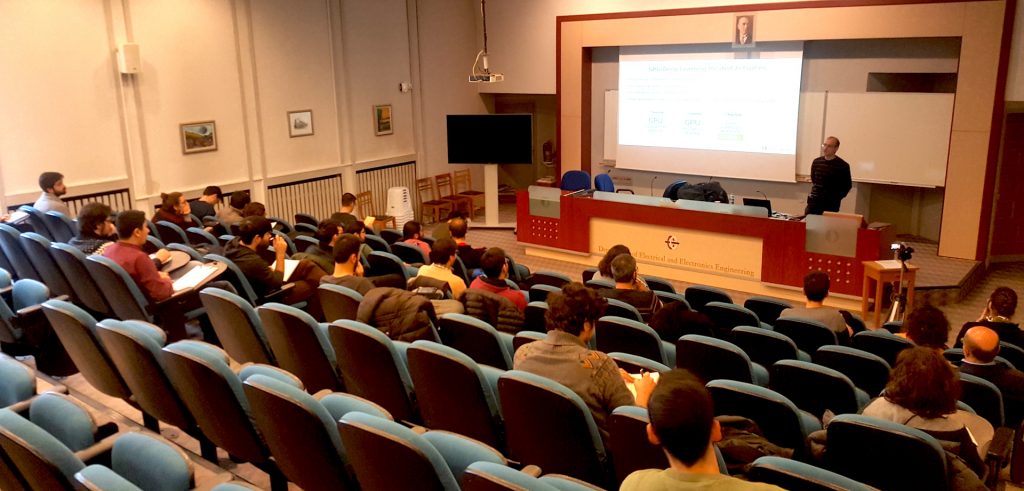
vTools Link: https://events.vtools.ieee.org/m/188797
—
07 December 2018 (13:40): IEEE AP/MTT/EMC/ED Turkey Seminar Series (S.41)
Speaker: Asst. Prof. Serap Aksu, Koç University
Topic: “Seeing Proteins in the Infrared: Plasmofluidics and Spectroscopy”
Location: Middle East Technical University, Ankara, Turkey
Abstract: Combination of Photonics with Biology has been generating smart solutions for chronic methodological problems in biology. In this talk I will explain a variety of plasmonic biosensors operating in optical frequencies and their applications on spectroscopy. I will show how we use them to detect and identify even few amounts of proteins in the context of immune cell signaling.
Bio: Serap Aksu has been an Assistant Professor at Koç University, Physics Department. She received her PhD from Boston University in 2013 and BS from Sabancı University in 2008, both in Materials Science and Engineering. She worked in ETH Zurich Biosystems Science and Engineering as postdoctoral fellow. She is the recipient of AXA Research Fund, Outstanding Dissertation Award from Boston University and ETH Zurich Postdoctoral Fellowship.
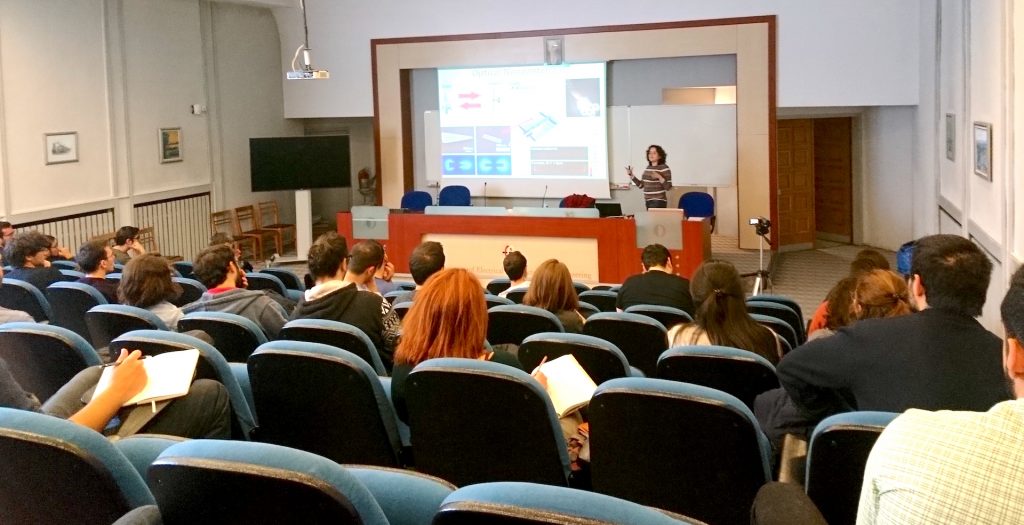
vTools Link: https://events.vtools.ieee.org/m/184352
—
23 November 2018 (13:40): IEEE AP/MTT/EMC/ED Turkey Seminar Series (S.40)
Speaker: Assoc. Prof. Sinan Kalkan, Middle East Technical University
Topic: “Context in Robots”
Location: Middle East Technical University, Ankara, Turkey
Abstract: In many of our cognitive capabilities and perceptual processes, we (humans) rely on vast amount of background knowledge and stimuli that we call context. Robots that are expected to populate our daily lives in near future should use such contextual information, and perceive, act, reason and plan accordingly. In this talk, after providing a short summary of how context helps us (humans) and the use of contextual cues in the robotics literature, I will present some of our recent work on incremental and hierarchical modeling of context in robots.
Bio: Dr. Sinan Kalkan received his M.Sc. degree in Computer Engineering from Middle East Technical University, Turkey in 2003, and his Ph.D. degree in Informatics from the University of Göttingen, Germany in 2008. After working as a postdoctoral researcher at the University of Gottingen and at Middle East Technical University, he became an assistant professor at Middle East Technical University in 2010. Since 2016, he has been working as an associate professor. Sinan Kalkan’s research interests include Computer Vision, and Developmental Robotics. In Computer Vision, he has been working on depth estimation, stereo vision and object detection. In Developmental Robotics, he has been focusing on scene modeling, context modeling and life-long learning for the last couple of years.
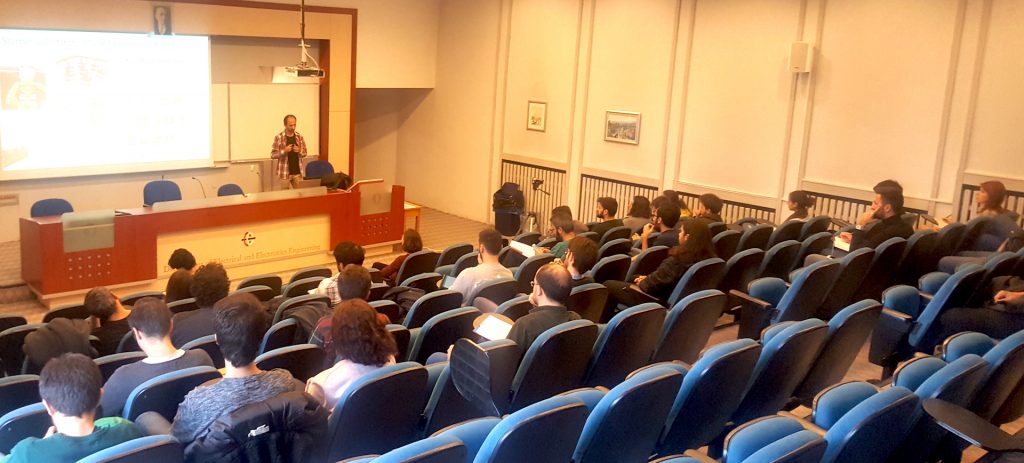
vTools Link: https://events.vtools.ieee.org/m/182834
—
16 November 2018 (13:40): IEEE AP/MTT/EMC/ED Turkey Seminar Series (S.39)
Speaker: Prof. Hamza Kurt, TOBB-ETÜ
Topic: “Slow Light and Optical Cloaking”
Location: Middle East Technical University, Ankara, Turkey
Abstract: In recent years, there have been huge research efforts in the field of nanophotonics to reduce the speed of light (ultimately reaching zero group velocity) and manipulate the way that light interacts with the objects. While optical communication ensures high speed data transportation what would be the benefits of slowing down the light propagation in optical waveguides. Similarly, detection and imaging are very important applications of photonics. However, making an object invisible (if possible) at first seems counterintuitive. The importance of optical invisibility and slow light studies will be explained during the presentation.
Bio: Hamza Kurt received the B.S. degree from Middle East Technical University (METU), Ankara, Turkey, in 2000, the M.S. degree from the University of Southern California (USC), Los Angeles, CA, USA, in 2002, and the Ph.D. degree from the Georgia Institute of Technology (Georgia Tech), Atlanta, GA, USA, in 2006, all in electrical and electronics engineering. He was a Research Fellow with the Cedars-Sinai Medical Center, Bio-photonics Research Lab, Los Angeles, from 2001 to 2002. He was a post-doctoral Research Fellow with Georgia Tech for a short period and then he has spent a year with the Institut d’Optique Graduate School, Paris, France, as a post-doctoral Scientist. Since December 2007, he has been with the TOBB University of Economics and Technology, Ankara and promoted to full-professor level in 2015. He has published more than 90 peer-reviewed scientific papers including two invited papers and six single-author papers. He has given contributed and invited presentations and published more than 100 conference abstracts and proceedings. His current research interests include nanophotonics including the design and analysis of nanophotonic materials and media for the realization of wavelength and sub-wavelength scale optical elements, slow light structures, graded index optics, high-resolution imaging, polarization insensitive devices, optical cavities/waveguides, optical biosensors, and metasurfaces (flat-optics).
Prof. Kurt received the Outstanding Faculty of the Year Award 2010, TOBB University and Turkish Academy of Sciences Distinguished Young Scientist Award (TUBA-GEBIP) 2010. He is a member of the Optical Society of America, IEEE Photonics Society and associate member of Turkish Academy of Sciences. He is director of nanophotonics research group at TOBB University in Ankara.
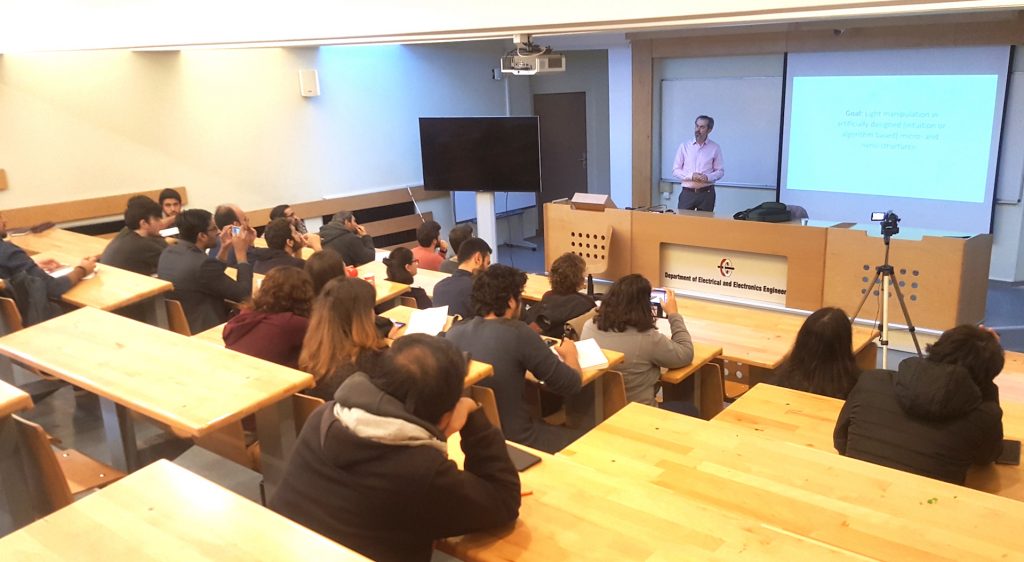
vTools Link: https://events.vtools.ieee.org/m/182727
—
09 November 2018 (13:40): IEEE AP/MTT/EMC/ED Turkey Seminar Series (S.38)
Speaker: Asst. Prof. Onur Özcan, Bilkent University
Topic: “Design, Manufacturing, And Locomotion Of Miniature Robots”
Location: Middle East Technical University, Ankara, Turkey
Abstract: Biological research over the past several decades has elucidated some of the mechanisms behind highly mobile, efficient, and robust locomotion in insects and small animals. Roboticists try to use this information to create biologically inspired miniature machines capable of running, jumping, and climbing robustly over a variety of terrains. However, despite the recent advances in the field of miniature robotics, the design and capabilities of these robots are still very limited due to unavailablity of fabrication methods and our poor grasp of physics behind miniature robot locomotion. This talk addresses these challenges, focusing on the mechanical design and fabrication of Bilkent miniature robots and the static and dynamic modeling efforts conducted. Miniature robots have the potential for use in hazardous environments, as well as being ideal tools to investigate locomotion at small scales.
Bio: Dr. Onur Özcan creates bio-inspired miniature ambulatory robots through research at the interface of mechanical engineering and robotics. He received his B.S. (2007) in Mechatronics Engineering at Sabancı University and his M.S. (2010) and Ph.D. (2012) in Mechanical Engineering at Carnegie Mellon University in Pittsburgh, Pennsylvania, USA, where he worked on control and automation of tip-directed nanoscale fabrication. As a postdoctoral fellow, he conducted research on fabrication and control of miniature crawling robots at Harvard University’s School of Engineering and Applied Sciences and the Wyss Institute for Biologically Inspired Engineering from April 2012 to January 2015. Following his postdoctoral position, he joined Bilkent University Mechanical Engineering Department as an Assistant Professor in January 2015.
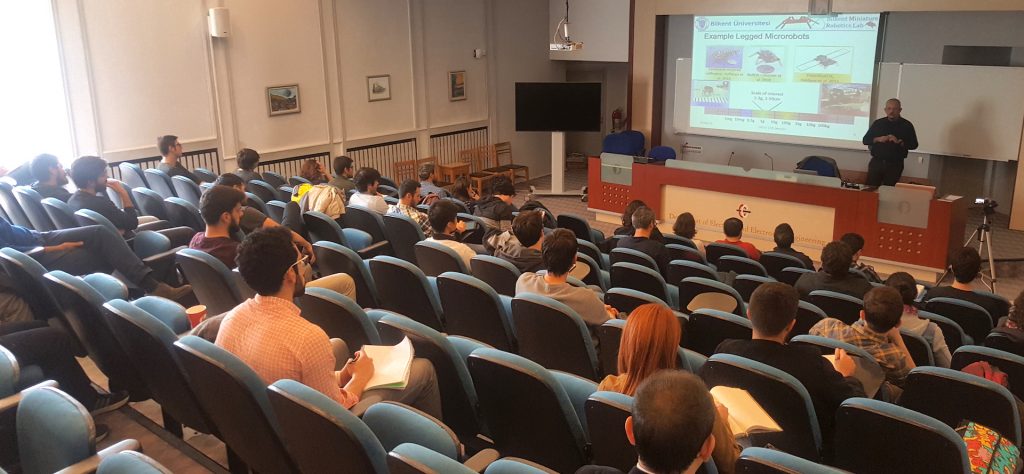
vTools Link: https://events.vtools.ieee.org/m/182726
—
02 November 2018 (13:40): IEEE AP/MTT/EMC/ED Turkey Seminar Series (S.37)
Speaker: Asst. Prof. Nazlı İkizler Çinbiş, Hacettepe University
Topic: “Recognition of Human Interactions and Collective Activities”
Location: Middle East Technical University, Ankara, Turkey
Abstract: In this talk, I will give an overview about the recent algorithms that we have been working on at the Hacettepe Computer Vision Lab regarding human activity understanding. First, I will introduce “Histogram of Sequences”, a video representation that aims at effective recognition of human interactions. This method basically combines the power of discriminative sequence mining and histogram representation, by mining sequences of the visual features that occur consequently in space and time. As an extension to base model, we incorporate a hierarchical temporal pyramid mechanisation, where the height of the temporal pyramid determines the temporal scales of the sequences. This new representation is likely to cover more complex spatiotemporal relationships such that the temporal variability of local sequences can be more accurately modelled. In the second part of my talk, I will present our work on collective activity recognition that analyses the behaviour of groups of people in videos. In this context, I will introduce “region-based multi-stream convolutional neural networks”, where we extend the successful two-stream convolutional neural network architecture to handle multiple regions of interest in conjunction with the regular RGB and optical flow streams. In this context, we explore several ways of fusing multiple spatial and temporal streams so that the accuracy of recognition can be improved.
Bio: Dr. Nazlı İkizler Cinbiş received her BSc and MSc degrees from Department of Computer Engineering at Bilkent University. During 2005-2006, she was a visiting scholar at University of Illinois at Urbana-Champaign (UIUC). After receiving her PhD degree from Bilkent University in 2008, she worked as a post-doctoral research associate at Boston University (USA). Since 2011, she works as an Assistant Professor at Hacettepe University Department of Computer Engineering. She is amongst the founders of the Hacettepe University Computer Vision Laboratory (HUCVL). She is an associate editor of the IET Computer Vision journal since 2016 and has served as an area chair for CVPR 2018. Her research areas are mainly computer vision and machine learning, specifically focusing on video processing, human action and interaction recognition in images and videos and zero-shot learning. For more information, please visit http://web.cs.hacettepe.edu.tr/~nazli
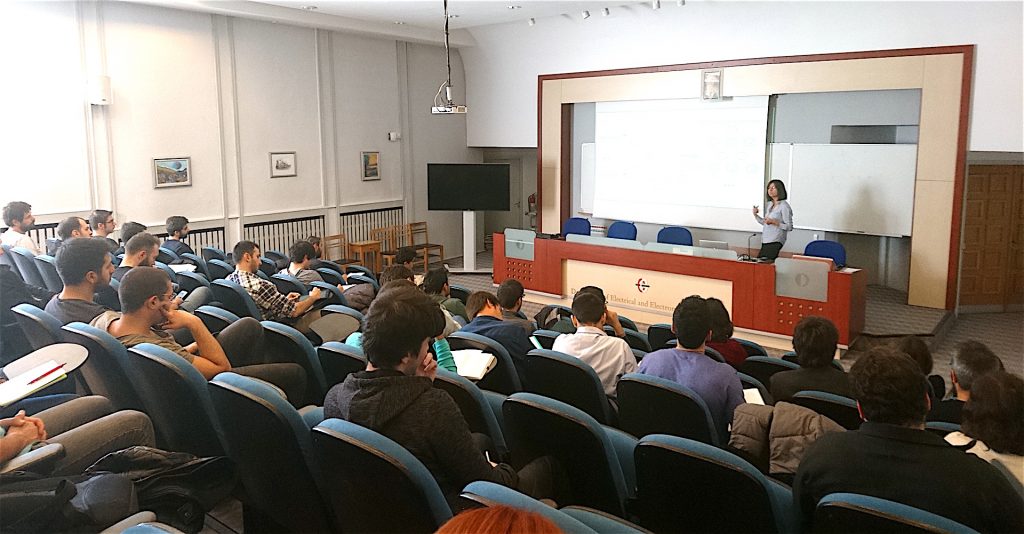
vTools Link: https://events.vtools.ieee.org/m/181388
—
26 October 2018 (13:40): IEEE AP/MTT/EMC/ED Turkey Seminar Series (S.36)
Speaker: Mehmet Altuntaş, Hüzme Savunma
Topic: “Antenna Technologies for Defense Systems”
Location: Middle East Technical University, Ankara, Turkey
Abstract: An antenna is the interface between radio waves propagating through space and electric currents moving in metal conductors. They can be used as a transmitter or receiver. By the help of an antenna, you can transmit/receive signals up to thousands of kilometers. In this talk, we will first concentrate on the basics of antenna. Then, we will describe antenna engineering, and finally, we will talk about antenna technologies for defense systems.
Bio: Mehmet Altuntaş was born in Nurnberg/Germany, on 30 December 1979. He graduated from Samsun Anatolian High School in 1997, and from Middle East Technical University a Bachelor of Electrical and Electronics Engineering in June 2002. He got his Masters of Science degree in Electrical and Electronics Engineering in December 2002 from Middle East Technical University. Although he started Philosophy of Doctorate, he did not finish it. After receiving his BSc, Mehmet Altuntaş started to work for ASELSAN between 2002-2006. The main topics that he worked were antennas, HP, LP and BP filters, antenna measurements in anechoic chamber, antenna measurements in the near field antenna measurement test setups, antenna measurements in the far field and near field in the open air antenna test site, Rx-Tx system design, etc. After ASELSAN, he started to work for Vestel Defence from 2006 to 2009 as an radar and communications systems engineer. Between 2009-2017 he worked for Meteksan Defence as an electromagnetics technical leader. The main topics were Several Antenna designs and manufacture (conformal, planar, array, blade, monopole, GPS,..), phased array antenna design, installing far field antenna measurement range, installing near field antenna measurement range, EMI/EMC Measurement, RF link budget, system design. From 2018 he has been the managing partner of Huzme Defense Inc. Huzme Defense was founded in 2018 with the aim of producing solutions for all industrial establishments in the fields of its activity, especially in defense and aeronautical sectors, in particular in the fields requiring specific expertise such as antennas and radom. Huzme Defense employees have experience in antennas (omni-directional, directional, phased array, dish, helical, active antennas, etc.) and radome design for land, naval and airborne platforms.
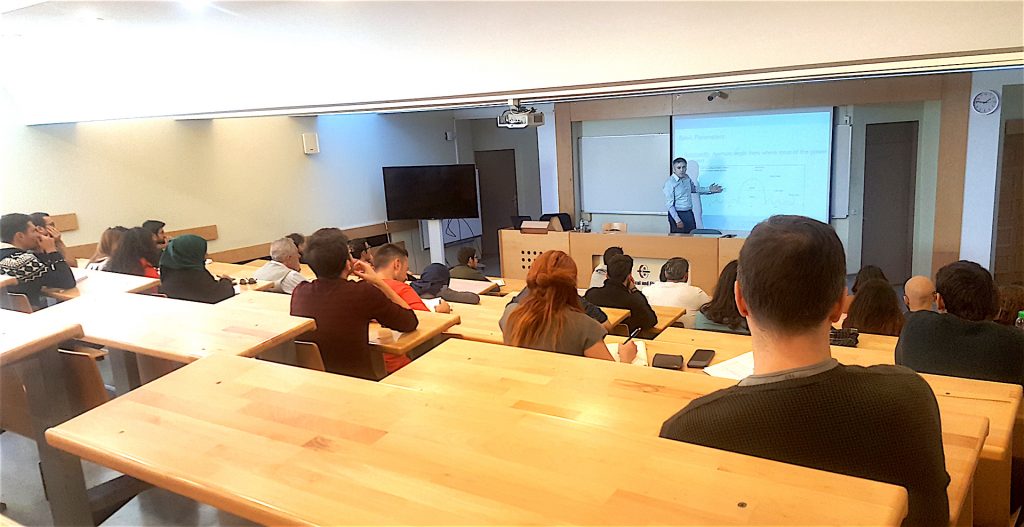
vTools Link: https://events.vtools.ieee.org/m/180093
—
19 October 2018 (13:40): IEEE AP/MTT/EMC/ED Turkey Seminar Series (S.35)
Speaker: Asst. Prof. Seniha Esen Yuksel, Hacettepe University
Topic: “Can You “See” the Target in the Shadow?”
Location: Middle East Technical University, Ankara, Turkey
Abstract: Hyperspectral cameras are a special set of cameras which collect hundreds of images from across the electromagnetic spectrum. In doing so, it is possible to label every single pixel based on its material content; such as asphalt, grass, water etc. This incredible information on materials can be used in a variety of fields from agriculture to astronomy, medical imaging and defense. However, one hurdle occurs when the light is simply not there to collect: targets hidden in shadow regions are very difficult to detect from hyperspectral images. One way to mitigate this problem is to detect the shadow areas using light detection and ranging (LiDAR) sensors, and to correct for the hyperspectral data in these regions. In this talk, we will first introduce the hyperspectral and LiDAR sensors and explain the physical radiance model. Then, we will describe our efforts to combine LiDAR and hyperspectral data in the shadow regions using the physical radiance model; and show that this significantly increases the target detection rates in shadow regions.
Bio: Seniha Esen Yuksel received the B.Sc. degree in electrical and electronics engineering from the Middle East Technical University, Ankara, Turkey, in 2003; the M.Sc. degree in electrical and computer engineering from the University of Loisville, Louisville, USA in 2005; and the Ph.D. degree in computer engineering from the University of Florida, Gainesville, FL, USA in 2011. She then worked as a postdoctoral researcher at the materials science department of University of Florida, and as a lecturer at the Middle East Technical University Northern Cyprus Campus. Currently, Dr. Yuksel is an assistant professor at the Hacettepe University, Department of Electrical and Electronics Engineering. She is also the director of the Pattern Recognition and Remote Sensing Laboratory (PARRSLAB http://parrslab.ee.hacettepe.edu.tr), where she is doing research on machine learning and computer vision with applications in defense and medical industry. Her latest projects include fusion of hyperspectral and LiDAR data, target detection from ground penetrating radar data, landmine, explosives and substance detection from hyperspectral and thermal images. Her lab is always open to collaborators, talented graduate as well as undergraduate students.
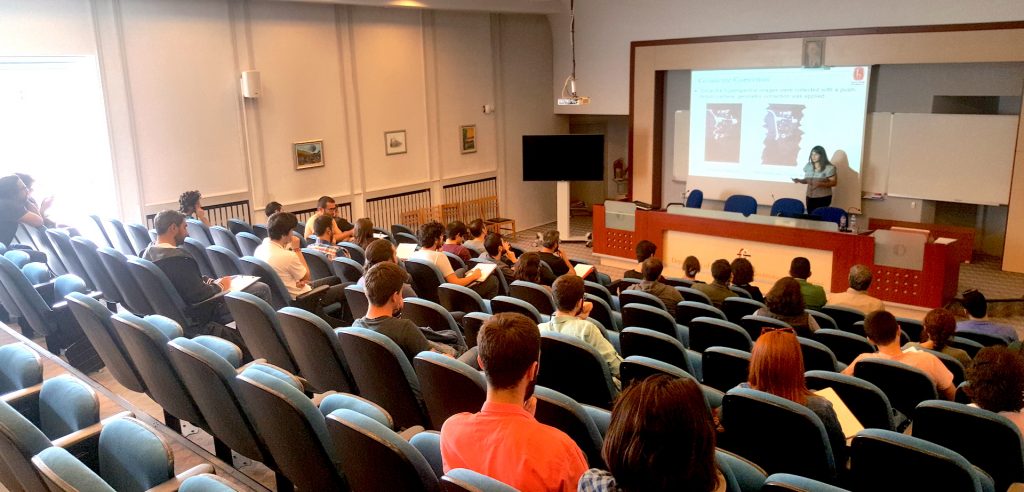
vTools Link: https://events.vtools.ieee.org/m/180091
—
18 May 2018 (13:40): IEEE AP/MTT/EMC/ED Turkey Seminar Series (S.34)
Speaker: Dr. Salih Zengin, TUBITAK SAGE
Topic: “Hardware Based String Matching Architectures”
Location: Middle East Technical University, Ankara, Turkey
Abstract: Many fields of computing such as Deep Packet Inspection (DPI) employ string matching modules (SMM) that search for a given set of positive strings in their input. An SMM is expected to produce correct outcomes while scanning the input data at high rates. Furthermore the string sets that are searched for are usually large and their sizes increase steadily. Bloom Filters (BFs) are hashing data structures which are fast but their false positive results require further processing. That is, their speed can be exploited for Standard Bloom Filter SMMs (SBFs) as long as the positive probability is low. Multiple BFs in parallel can further increase the throughput. In this paper, we propose the Double Bloom Filter SMM (DBF) which achieves a higher throughput than the SBF and maintains a high throughput even for large positive probabilities. The second Bloom Filter of DBF stores a small enough subset of the positive strings such that its false positive probability is approximately zero. We develop an analytical model of the DBF and show that the throughput advantage of DBF over SBF becomes more prominent if the positive probability and the fraction of matches in the second Bloom Filter increase. Accordingly, we propose a heuristic algorithm that stores the strings that are more frequently matched in the second Bloom Filter according to localities identified in the input. Our numerical results are obtained using realistic values from an FPGA implementation and are validated by SystemC simulations.
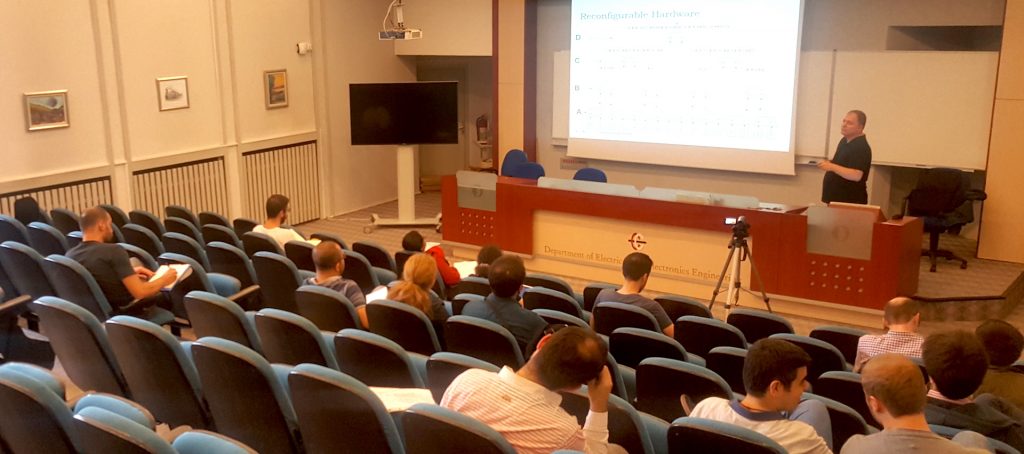
vTools Link: https://events.vtools.ieee.org/m/173303
—
16 May 2018 (14:40): IEEE AP/MTT/EMC/ED Turkey Seminar Series (S.33)
Speaker: Prof. Levent Sevgi, Okan University
Topic: “Electromagnetic Diffraction Modeling and Simulation”
Location: Middle East Technical University, Ankara, Turkey
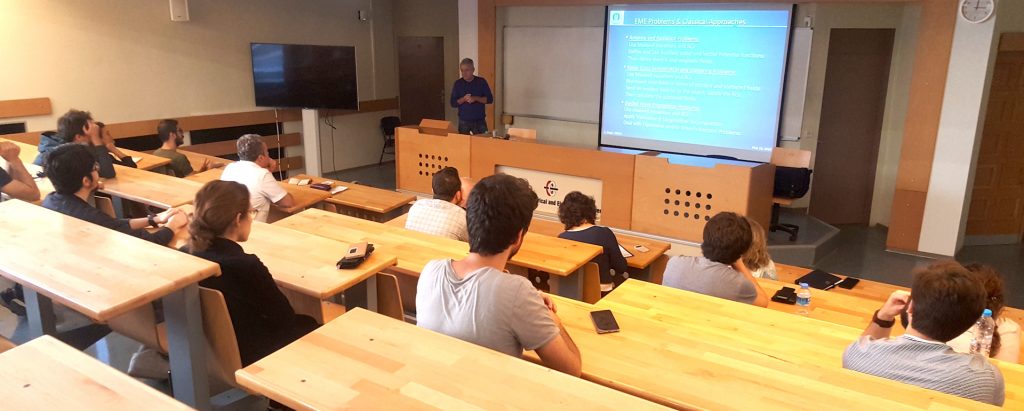
vTools Link: https://events.vtools.ieee.org/m/173195
—
11 May 2018 (13:40): IEEE AP/MTT/EMC/ED Turkey Seminar Series (S.32)
Speaker: Assoc. Prof. Klaus Werner Schmidt, Middle East Technical University
Topic: “Supervisory Control for Discrete Event Systems: Introduction, Methods and Applications”
Location: Middle East Technical University, Ankara, Turkey
Abstract: Discrete event system (DES) models are suitable to describe man-made systems such as manufacturing systems, automation systems, telecommunication networks, traffic systems or logistic systems. As a common feature, such systems have a discrete state space and their dynamic behavior is driven by the occurrence of asynchronous events. Moreover, such systems are usually composed of a large number of interacting components such that systems of practical size have a very large state space. Accordingly, the controller (supervisor) design for DES is a challenging problem and requires advanced concepts such as modularity and system abstraction. This talk first introduces the DES modeling framework and discusses the basic supervisory control framework. Then, the ideas of modularity and system abstraction are outlined in order to reduce the design complexity. Application examples illustrate that the described concepts are applicable to systems of practical size and support the idea of “correctness by design”.
Bio: Klaus Werner Schmidt received the Diploma and Ph.D. degrees in electrical, electronic, and communication engineering from University of Erlangen-Nürnberg, Germany, in 2002 and 2005, respectively. He is currently an Associate Professor with the Department of Electrical and Electronics Engineering, Middle East Technical University, Ankara. His research interests include supervisory control for discrete event systems, industrial automation systems, industrial communication networks, intelligent transportation systems, and industrial project control. He is an Associate Editor of the journal “Discrete Event Dynamic Systems: Theory and Applications” and of the “Turkish Journal of Electrical Engineering & Computer Sciences”.
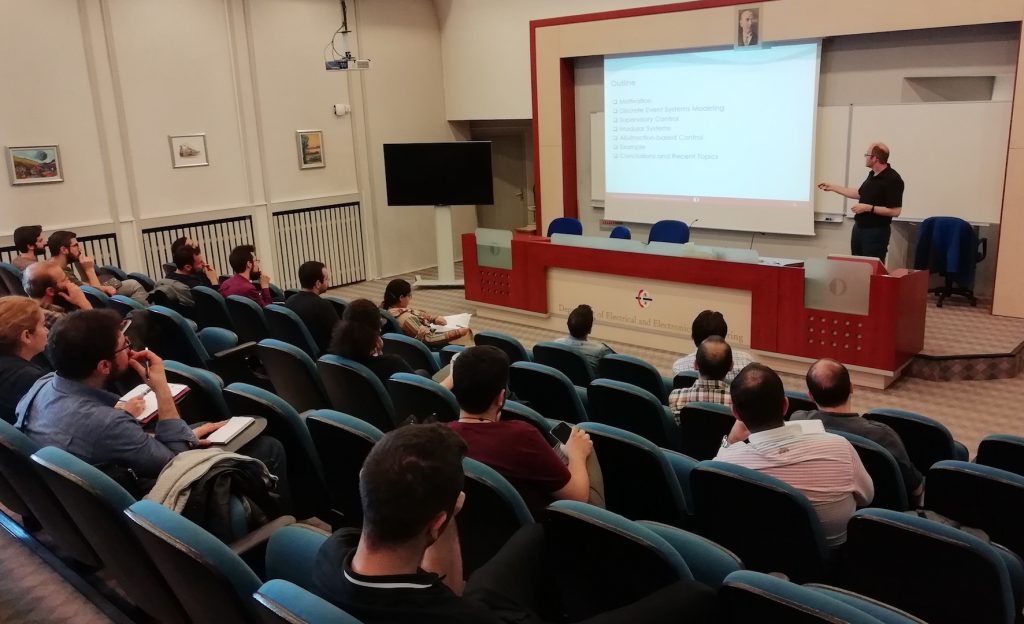
vTools Link: https://events.vtools.ieee.org/m/173147
—
4 May 2018 (13:40): IEEE AP/MTT/EMC/ED Turkey Seminar Series (S.31)
Speaker: Asst. Prof. Ozan Keysan, Middle East Technical University
Topic: “An Introduction to Superconductivity and Its Applications in the Energy Area”
Location: Middle East Technical University, Ankara, Turkey
Abstract: The first superconducting material is discovered over a century ago, but for a long time superconductors couldn’t find any practical applications. Since the discovery of high-temperature superconductors, they have been proposed to be used in different commercial applications. One of the promising area for the superconductivity is the energy area, in which they can be used in practical applications such as magnetic-levitation trains, power generation, electricity transmission etc. Superconductors can enable much higher efficiencies, at increased power ratings with just a fraction of the size of a conventional copper wire. However, currently superconductors has to be cooled down to cryogenic temperatures to get into superconductivity state, which introduces many engineering challenges for commercial applications. In this talk, basic properties of superconducting materials and a brief history of discoveries on superconductivity will be presented. Up-to-date applications and commercial products will be summarized and current challenges and the trends will be discussed. No need to have any previous knowledge in the field 🙂
Bio: Ozan Keysan received his B.S. and M.S. degrees in Electrical and Electronics Engineering from the Middle East Technical University, in 2005 and 2009, respectively. He got his Ph.D. degree in Institute for Energy Systems, University of Edinburgh in 2013. His research interests mainly focus on renewable energy, design of electrical machines, smart-grids and superconductivity. He is currently an assistant professor in Electrical and Electronics Engineering, Middle East Technical University. He is one of the principal investigators of the METU PowerLab research group. ( http://power.eee.metu.edu.tr ). More information can be found from: http://keysan.me
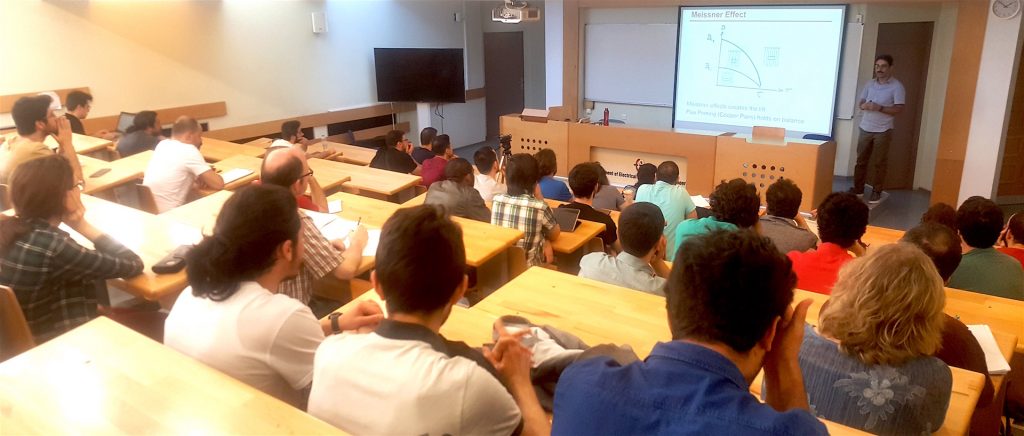
vTools Link: https://events.vtools.ieee.org/m/173146
—
27 April 2018: IEEE-APS Distinguished Lecturer Seminar by Prof. Jianming Jin
Topic: “Multiphysics Modeling in Computational Electromagnetics: Challenges and Opportunities”
Location: Bilkent University, Ankara, Turkey
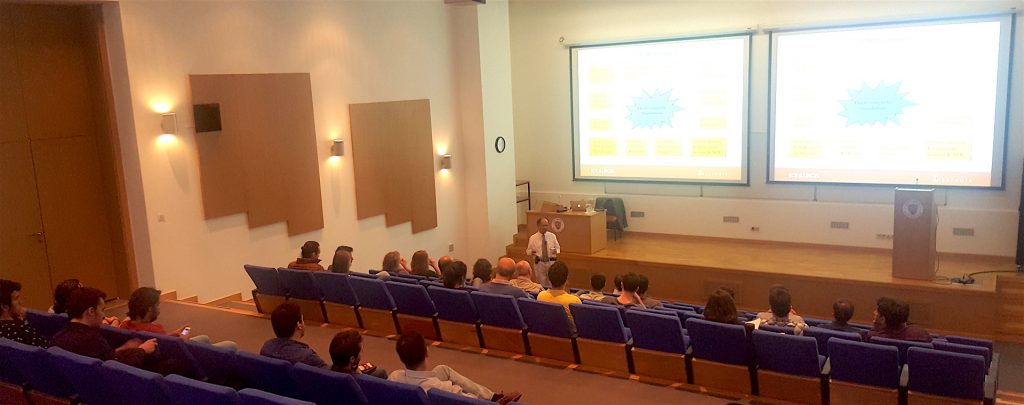
vTools Link: https://events.vtools.ieee.org/m/172292
—
26 April 2018: IEEE-APS Distinguished Lecturer Seminar by Prof. Jianming Jin
Topic: “The Fascinating World of Computational Electromagnetics”
Location: Middle East Technical Univesity, Ankara Turkey
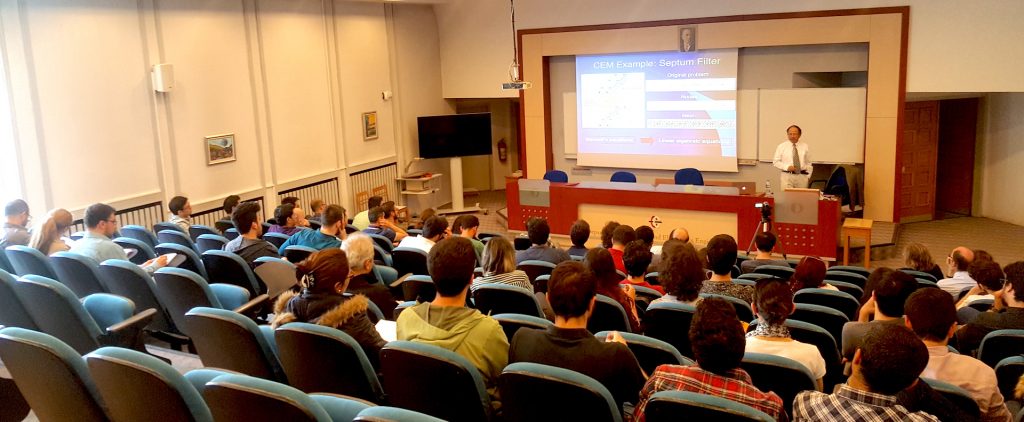
vTools Link: https://events.vtools.ieee.org/m/172291
—
20 April 2018 (13:40): IEEE AP/MTT/EMC/ED Turkey Seminar Series (S.30)
Speaker: Prof. Engin Tuncer, Middle East Technical University
Topic: “Acoustics and Video: Reflections on Engineering Research and Education”
Location: Middle East Technical University, Ankara, Turkey
Abstract: Engineering and particularly Electrical Engineering is rapidly evolving. The forces that shape this field come from diverse fields. Two very important factors in this area are the consumers and the industry. The huge budgets of private firms allow them to attract young and talented engineers and this shifts the traditional center of gravity for research and development from universities to the private firm laboratories. In this talk, we will point this problem and talk about the possible actions universities can take for research and education using examples from the acoustics and video applications.
Acoustics is a very mature area with several interesting applications for Electrical Engineering. There are several advantages and disadvantages of acoustic sensors in comparison to other well known sensors such as RF sensors. While acoustic signal processing is relatively easy, the nonlinear, quickly changing behavior of acoustic scene in real world, makes it very hard to deal with acoustic events. In this talk, we will consider a very distinct problem in detection and estimation, namely the acoustic shot detection problem. The use of sonic and supersonic wave features is important for the solution of the problem. Yet the field trials show that the problem is more complex than it is presented in the literature.
Video is one area that we humans would like to make machines function like we do. Hence today with the advent of new technologies like deep learning, IoT, etc, video processing is becoming a more vital tool in many engineering applications. While it is relatively a straightforward task to do video processing in MATLAB for many applications, it is far from anything simple if one tries to do that in real-time. In this seminar, we will talk about the FPGA implementation of video applications. Especially we will concentrate on the challenges in FPGA programming as well as its diverse applications in engineering, including sound camera, video generation, multiple camera applications and image blending.
Bio: Temel Engin Tuncer received the B.S. and M.S. degrees in Electrical and Electronics Engineering from the Middle East Technical University, Ankara, Turkey, in 1987 and 1989, respectively, and the Ph.D. degree in Electrical Engineering from Boston University, Boston, MA, in 1993. From 1991 to 1993, he was an Instructor and Adjunct Professor at Boston University. He joined the Electronics Engineering Department, Ankara University, in 1993. Since 1998, he has been with Middle East Technical University, where he is currently a Professor with the Electrical and Electronics Engineering Department. His research interests include statistical signal processing, signal processing for communications, sensor arrays and array signal processing, beamforming, multi-antenna and multi-user systems of cooperative communications, convex optimization, direction finding and localization, antenna and array design, multichannel systems, and embedded systems.
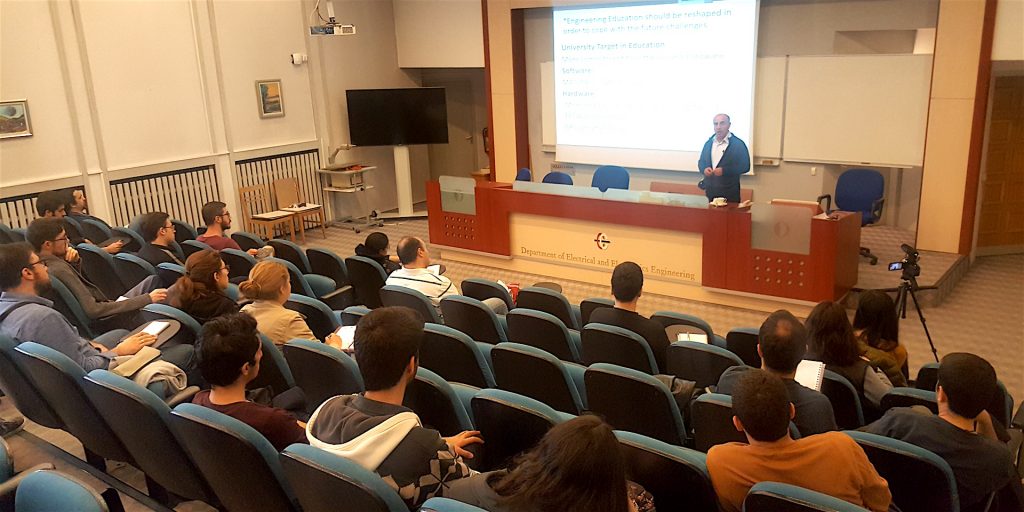
vTools Link: https://events.vtools.ieee.org/m/172243
—
13 April 2018 (13:40): IEEE AP/MTT/EMC/ED Turkey Seminar Series (S.29)
Speaker: Dr. Ilhan Varol, Hidromek A.S.
Topic: “Construction Machines – Getting Smarter”
Location: Middle East Technical University, Ankara, Turkey
Abstract: Construction machines are employed to build infrastructures, dams, roads and airports, etc. They have been manufactured since the start of the century and have shaped the civilization. Unlike earlier machines, today’s machines are quite complex and furnished with many sensors communicating with each other using complex algorithms to perform better with increased efficiency/productivity while providing the operator with greater comfort. In parallel to the aviation industry, construction machines are also adapting new technologies making the machines from “assisted” to “autonomous” mode in operation and functions. The presentation will explore yesterday’s, today’s and tomorrow’s construction machines to exhibit how they have evolved.
Bio: Dr. Ilhan Varol has been with Hidromek for the last 11 years. He has served as Engineering Manager at the Motor Grader Division and Backhoe Loader Division at Hidromek. Earlier, he has worked at Caterpillar, USA in various engineering and management positions after his graduation with a Ph.D in Engineering from The Ohio State University in 1991.
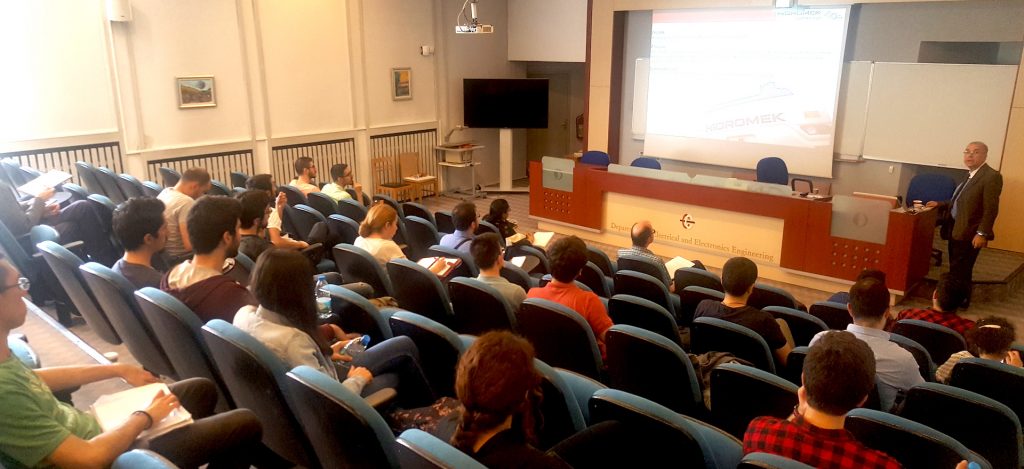
vTools Link: https://events.vtools.ieee.org/m/171581
—
06 April 2018 (13:40): IEEE AP/MTT/EMC/ED Turkey Seminar Series (S.28)
Speaker: Dr. Said Emre Alper, Mikrosistemler Co. Ltd.
Topic: “High Performance MEMS Gyroscopes and MEMS Accelerometers”
Location: Middle East Technical University, Ankara, Turkey
Abstract: Inertial sensors are the core integrated components that measure the position and orientation of any moving platform, currently ranging from cell phones to aircrafts. The cost and size advantages provided by microelectromechanical systems (MEMS) technologies enabled some newborn inertial sensing applications especially for consumer and industrial fields. Starting from 1990s, MEMS inertial sensors emerged into several commercial markets such as automotive engineering, household appliances, as well as robotics. Ongoing research in combination with the progress in MEMS fabrication technologies now yields even higher performance MEMS inertial sensors. Today, it is possible to realize MEMS accelerometers with several g bias stability and MEMS gyroscopes with bias stabilities approaching to and even lower than 1deg/hr. This talk will present an overview of MEMS inertial sensors as well as the current activities running at Mikrosistemler, the only MEMS company in Turkey that can design and produce its own gyroscopes and accelerometers.
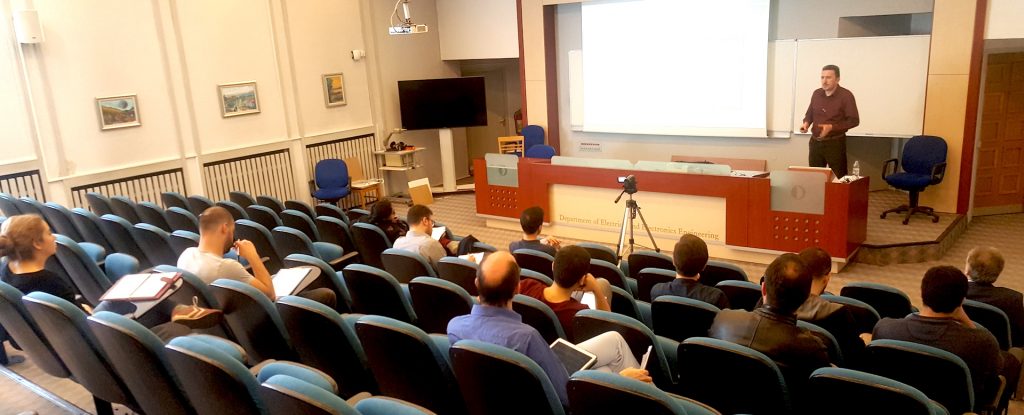
vTools Link: https://events.vtools.ieee.org/m/171580
—
30 March 2018 (13:40): IEEE AP/MTT/EMC/ED Turkey Seminar Series (S.27)
Speaker: Prof. Ali Serpengüzel, Koç University
Topic: “Silicon Microspheres and Meandering Waveguides for Fiber Optics and Integrated Photonics”
Location: Middle East Technical University, Ankara, Turkey
Abstract: Spherical optical microcavities [1] are building blocks of three dimensional photonics, as linear optical microcavities are building blocks of one dimensional photonics [2]. Dielectric and semiconductor [3] based lightwave circuit elements are integrated into fiber optics and integrated photonics. Specially, silicon microspheres lead themselves to various lightwave circuit element applications such as channel dropping filters [4] tunable filters, [5] and optical modulators [6] using optical fiber half couplers manufactured from single mode optical fibers. On the integrated optics side, silicon on oxide (SOI)-distributed feedback (DFB) meandering waveguides, as novel integrated optical elements, can exhibit a variety of spectral responses such as coupled resonator induced transparency filter, Fano resonator, hitless filter, Lorentzian filter, Rabi splitter, self coupled optical waveguide, and tunable power divider [7]. We focus on properties of silicon spherical resonators, and SOI-DFB meandering waveguides, and their potential for practical applications in fiber optics and integrated photonics.
[1] A. Serpengüzel, S. Arnold, and G. Griffel, “Excitation of Resonances of Microspheres on an Optical Fiber,” Opt. Lett. 20, 654-656 (1995).[2] A. Serpengüzel, A. Aydınlı, A. Bek, and M. Güre, “Visible photoluminescence from planar amorphous silicon nitride microcavities,” J. Opt. Soc. Am. B 15, 2706-2711 (1998).
[3] N. M. Gasanly, A. Serpengüzel, O. Gürlü, A. Aydınlı, and I. Yılmaz, “Dependence of the photoluminescence of Tl2InGaS4 layered crystal on temperature and excitation intensity,” Solid State Commun. 108, 525-530 (1998).
[4] Y.O. Yılmaz, A. Demir, A. Kurt, and A. Serpengüzel, “Optical Channel Dropping with a Silicon Microsphere,” IEEE Photon. Technol. Lett. 17, 1662-1664 (2005).
[5] A. Serpengüzel, A. Kurt, and U.K. Ayaz, “Silicon microspheres for electronic and photonic integration,” Photon. Nanostructur.: Fundam. Appl. 6, 179–182 (2008).
[6] E. Yüce, O. Gürlü, and A. Serpengüzel, “Optical Modulation with Silicon Microspheres,” IEEE Photon. Technol. Lett. 21, 1481-1483 (2009).
[7] C. B. Dağ, M. A. Anıl, and A. Serpengüzel, “Meandering Waveguide Distributed Feedback Lightwave Circuits,” J. Lightwave Technol, 33, 1691-1702 (2015).
Bio: Ali Serpengüzel received his Ph.D. in Applied Physics from Yale University. At Yale, he worked on stimulated Raman scattering from droplets and sprays. Later on, he joined Polytechnic University, Microparticle Photophysics Laboratory for postdoctoral work, where he performed the first coupling experiment of solid microspheres to optical fibers. Afterwards, he joined Bilkent University as a faculty member, where he concentrated his research on the optoelectronic properties of semiconductor microcavities. He is currently a Professor of Physics and the Director of the Koç University, Microphotonics Research Laboratory, Est. 2000. His current research focuses on integrated photonics with optical many novel microresonator and waveguide structures. Other research interests include optical spectroscopy in complex media, nanophotonics, nonlinear optics, and laser diagnostics. He is a fellow of SPIE, a senior member of IEEE and OSA, and a member of Sigma-Xi.
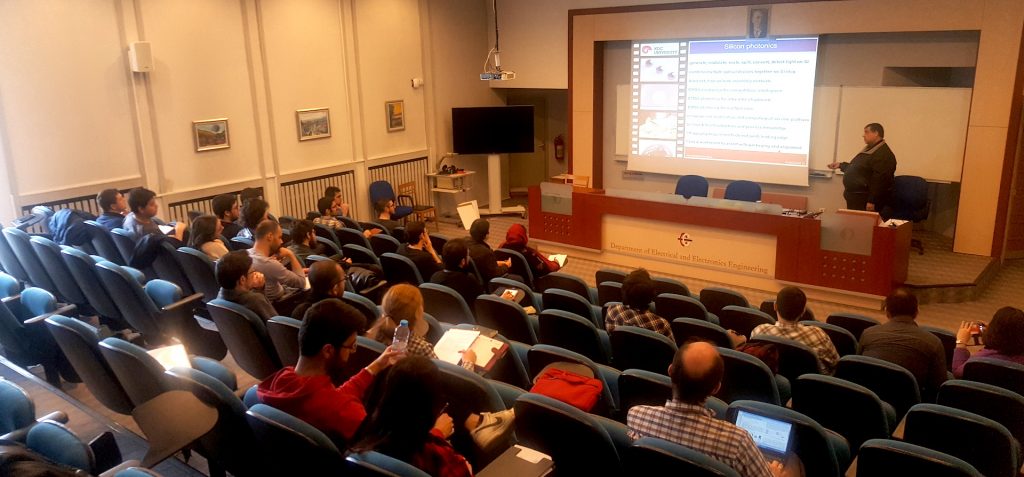
vTools Link: https://events.vtools.ieee.org/m/171187
—
23 March 2018 (13:40): IEEE AP/MTT/EMC/ED Turkey Seminar Series (S.26)
Speaker: Asst. Prof. Selçuk Yerci, Middle East Technical University
Topic: “Light Management in Photovoltaics”
Location: Middle East Technical University, Ankara, Turkey
Abstract: The global photovoltaics (PV) industry and installations in sun abundant regions in the World have been growing tremendously. PV now offers electricity at a price below $20 MW/h [1]. The roar of PV has been mainly based on implementation of well-developed know-how at lower cost. However, recently, new ideas are suggested to further increase the conversion efficiency of PV cells. This talk will start with an overview of PV research. Then, I will discuss the methods suggested to increase the efficiency of PV cells. Finally, I will focus on light management in photovoltaics to boost the efficiency [2,3].
References:
[1] https://www.greentechmedia.com/articles/read/mexico-auction-bids-lowest-solar-wind-price-on-the-planet#gs.csLLLUg [2] W. Hadibrata, F. Es, S. Yerci, R. Turan, “Ultrathin Si solar cell with nanostructured light trapping by metal assisted etching”, Sol. Energ. Mat. Sol. Cells, in press (2018) [3] G. Kartopu, D. Turkay, C. Ozcan, W. Hadibrata, P. Aurang, S. Yerci, H.E. Unalan, V. Barrioz, Y. Qu, L. Bowen, A.K. Gürlek, P. Maiello, R. Turan, and S.J.C. Irvine, “Photovoltaic performance of CdS/CdTe junctions on ZnO nanorod arrays”, Sol. Energ. Mat. Sol. Cells, 176, 100 (2018)Bio: Dr. Selçuk Yerci received his B.S. and M.S. in physics at Middle East Technical University and Ph.D. in Electrical Engineering at Boston University. His M.S. and Ph.D. research was mainly focused on silicon photonics, in particular silicon compatible light sources. After completing his Ph.D. he worked as a post-doctoral associate at the Massachusetts Institute of Technology on thin film crystalline silicon solar cells. Dr. Yerci is currently an assistant professor in Micro and Nanotechnology Programme, and in Electrical and Electronics Engineering at Middle East Technical University. Dr. Yerci continues his research activities in his research group (app.mnt.metu.edu.tr) under the Center for Solar Energy Research and Applications (GUNAM) laboratories (gunam.metu.edu.tr). His recent research is mainly focused on high-efficiency solar cells including material growth, device simulation and device fabrication aspects. Dr. Yerci has authored/co-authored over 35 articles and holding an h-index of 17.
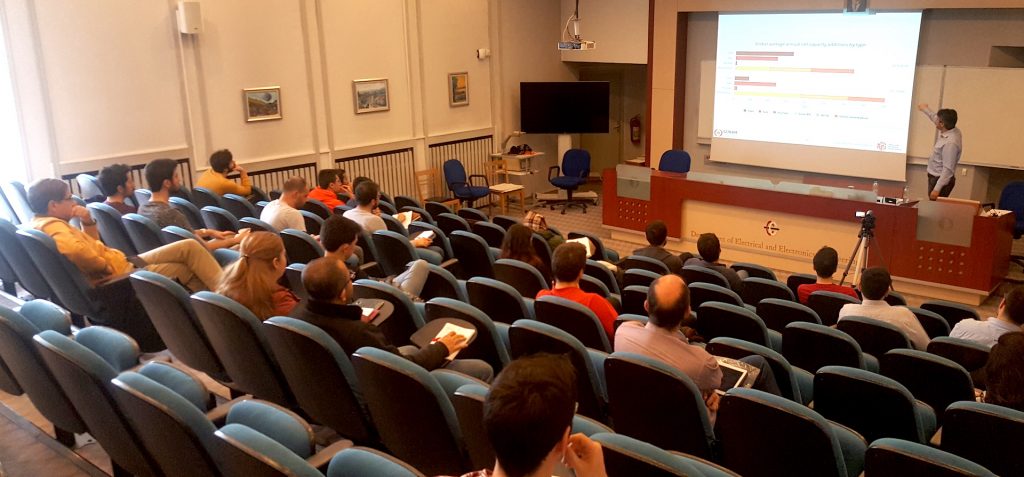
vTools Link: https://events.vtools.ieee.org/m/171186
—
16 March 2018 (13:40): IEEE AP/MTT/EMC/ED Turkey Course Series (C.1)
Lecturer: Prof. Sencer Koç, Middle East Technical University
Topic: “Antenna Measurements”
Location: Middle East Technical University, Ankara, Turkey
Abstract: This talk is about antenna measurement. The basic parameters used to characterize antennas and the techniques to measure such parameters are described. Methods and devices to measure antenna impedance and pattern are discussed. Antenna range requirements and characterization are explained. Open range and anechoic chambers and factors that introduce errors in measurement are presented.
Bio: Dr. Sencer Koç received his PhD degree from Electrical Engineering at the Middle East Technical University in 1987. He was a research assistant, assistant professor, and associate professor in the same department. Since 2010, he is a full professor, also in the same department. His research interests include general theory of electromagnetic fields, antenna theory and measurements, numerical methods for electromagnetics, radar systems, and RF-MEMS.
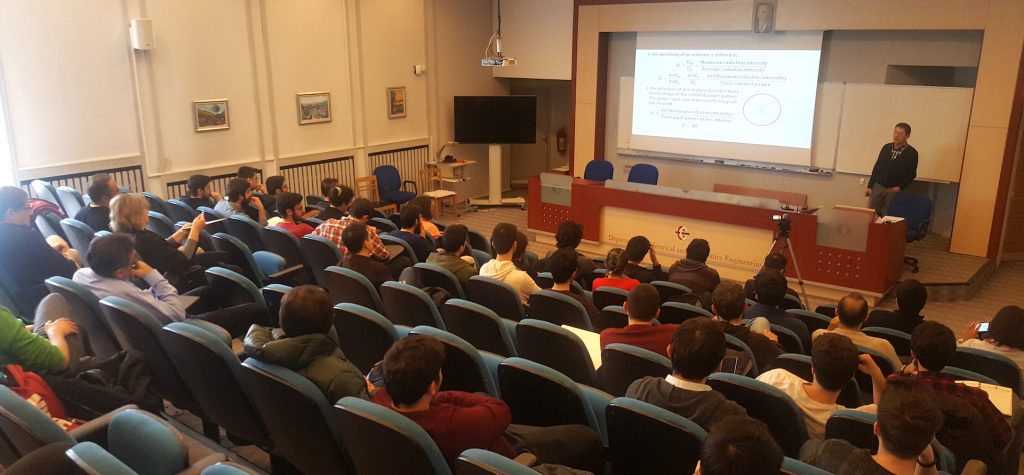
vTools Link: https://events.vtools.ieee.org/m/170467
—
09 March 2018: IEEE-EMC Distinguished Lecturer Seminar by Prof. Andy Marvin
Topic: “Shielding Enclosure Metrics”
Location: Bilkent University, Ankara, Turkey
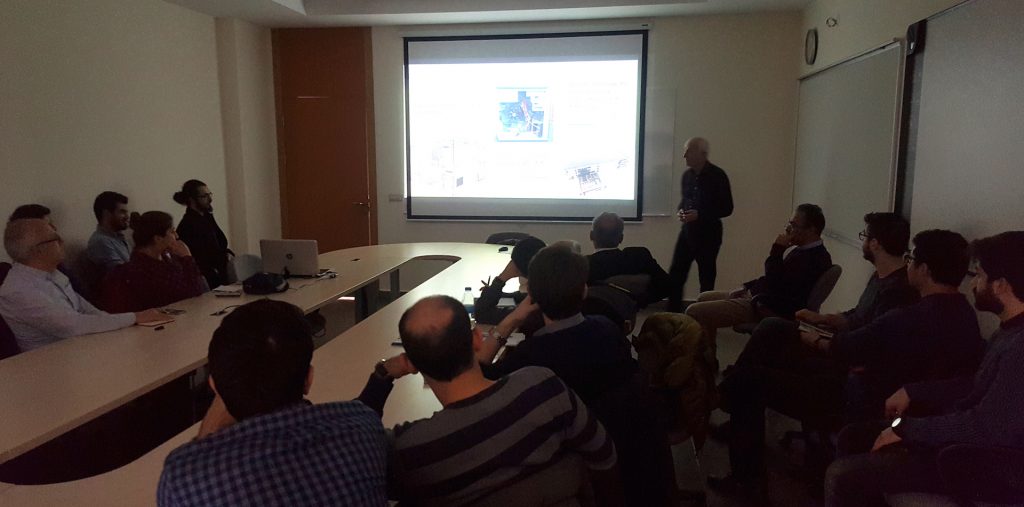
vTools Link: https://events.vtools.ieee.org/m/170466
—
07 March 2018: IEEE-EMC Distinguished Lecturer Seminar by Prof. Andy Marvin
Topic: “Shielding”
Location: Middle East Technical University, Ankara, Turkey
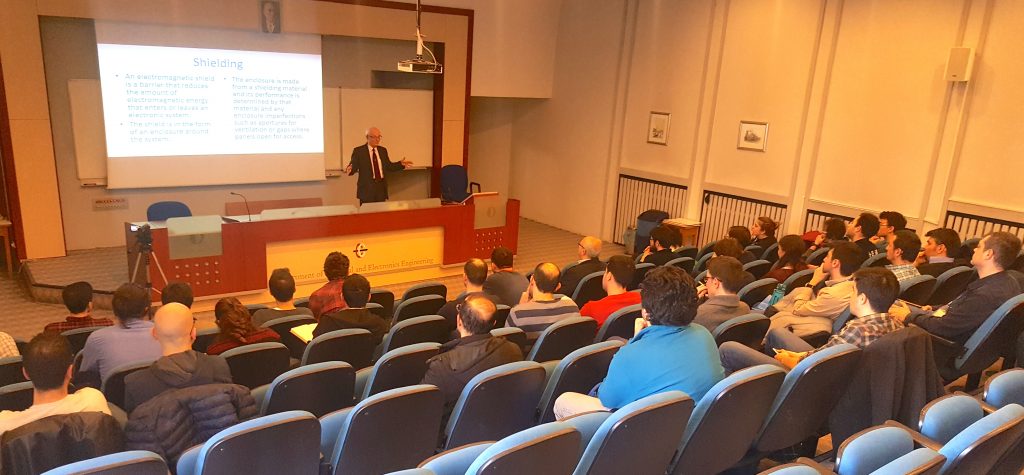
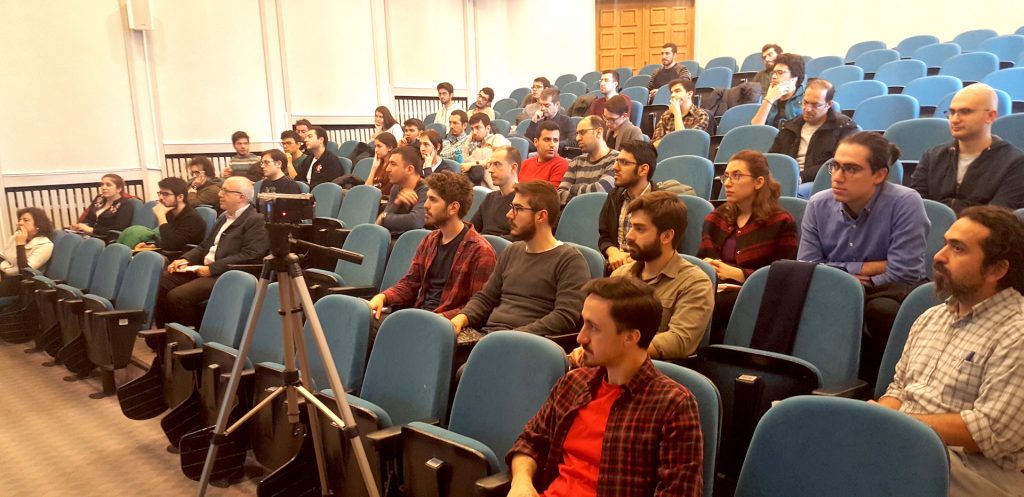
vTools Link: https://events.vtools.ieee.org/m/170464
—
02 March 2018 (13:40): IEEE AP/MTT/EMC/ED Turkey Seminar Series (S.25)
Speaker: Assoc. Prof. Özlem Özgün, Hacettepe University
Topic: “The Magic World of Transformation Electromagnetics: Invisibility and Beyond”
Location: Middle East Technical University, Ankara, Turkey
Abstract: In recent years, the concept of Transformation Electromagnetics (TEM) (or Transformation Optics) has attracted a considerable interest because it led to the design of a wide variety of electromagnetic and optical devices, such as invisibility cloak, reshapers, concentrators, rotators, RCS reduction of radar targets, flat lenses, miniaturization of antennas and microwave devices, etc. TEM is an intuitive approach for designing application-oriented transformation media that can flexibly tune electromagnetic waves in a desired manner by using the form invariance property of Maxwell’s equations under coordinate transformations. The theoretical foundations of TEM are on very firm foundation, and they have never been challenged. However, the physical realization of such transformation media poses challenges because of spatial variations of the material specifications. There are some promising studies in the literature related to the practical realization of such materials, thanks to the advancements in the metamaterial technology. Without dealing with the physical implementation of such materials, the reshaping approach, which have developed in 2007 just after the introduction of invisibility cloak in 2006, inspired us to utilize TEM to circumvent certain computational difficulties arising in the numerical solution of complex electromagnetic problems. Therefore, we named such materials as software metamaterials, and employed them in the numerical solution of multi-scale electromagnetic problems, rough surface scattering and optimization problems in the context of finite element and finite difference time domain methods. In this talk, first the fundamentals of TEM will be reviewed to understand the basic physics behind it. Afterwards, an overview of the past and present applications of this approach will be presented.
Bio: Dr. Özlem Özgün received her B.Sc. and M.Sc. degrees from Bilkent University, Ankara, Turkey in 1998 and 2000, respectively, and her Ph.D. degree from Middle East Technical University (METU), Ankara, Turkey in 2007, all in electrical and electronics engineering. She worked at Bilkent University as a teaching assistant during 1998-2000; at TÜBİTAK-İltaren during 2000-2004; at ASELSAN during 2004-2005; at Electromagnetic Communication Lab, Penn State University, USA as a postdoctoral researcher during 2007-2008; at METU Northern Cyprus Campus as an assistant professor during 2008-2012; and at TED University as an associate professor during 2012-2015. Currently, she is an associate professor in the electrical and electronics engineering department of Hacettepe University. Dr. Özgün’s research interests include computational electromagnetics, finite element method, domain decomposition methods, transformation electromagnetics, electromagnetic scattering, stochastic electromagnetic problems and optimization techniques. She has published over 100 refereed journal papers, book, book chapters, and conference articles. She received METU best Ph.D. thesis award in 2007, and the award for excellence in electromagnetics bestowed by Prof. Felsen Fund in 2009. She is a senior member of IEEE, and the secretary of the steering committee of URSI Turkey.
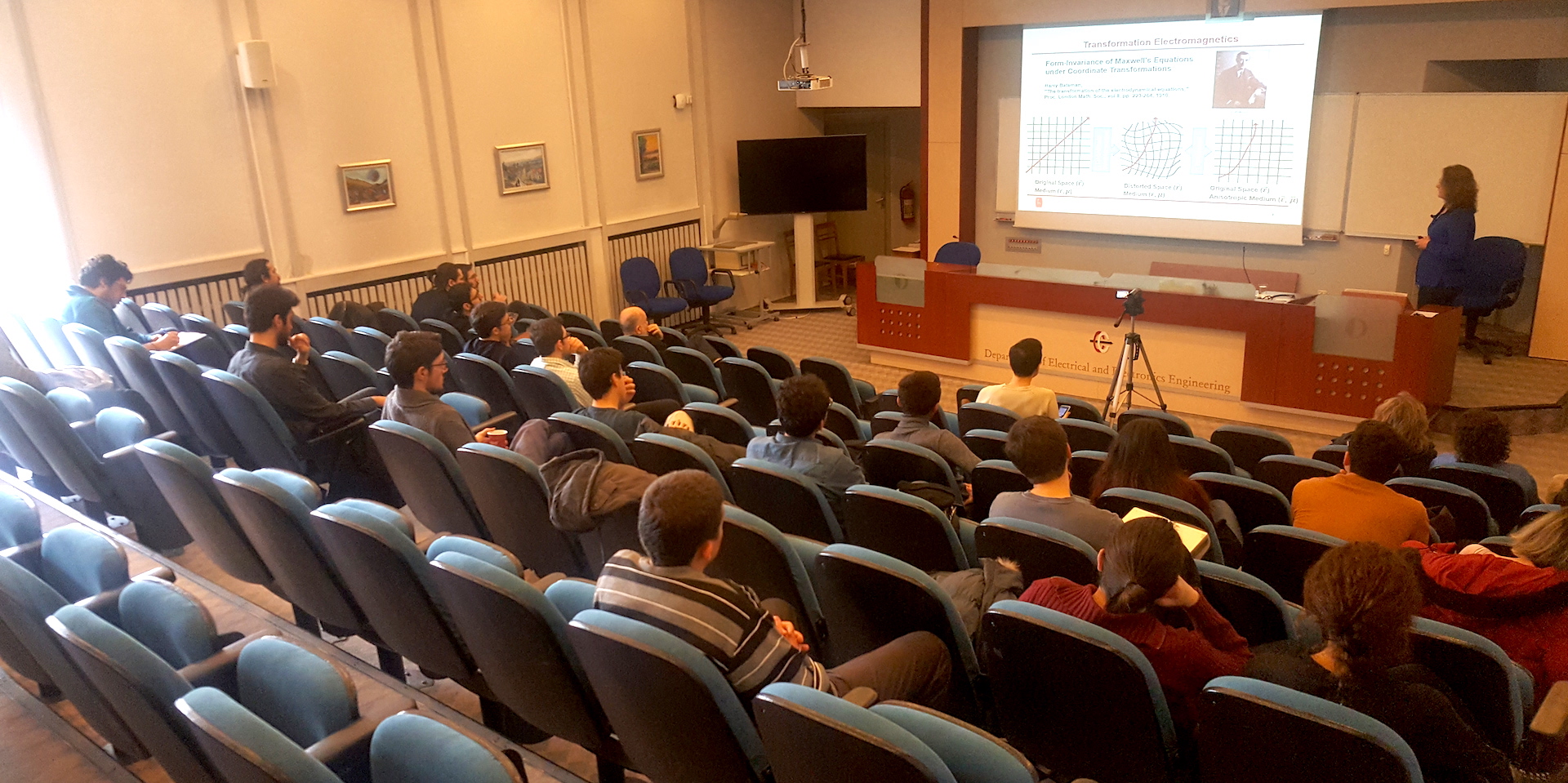
vTools Link: https://events.vtools.ieee.org/m/169621
—
23 February 2018 (13:40): IEEE AP/MTT/EMC/ED Turkey Seminar Series (S.24)
Speaker: Prof. Tayfun Akın, Middle East Technical University
Topic: “METU-MEMS Center”
Location: Middle East Technical University, Ankara, Turkey
Abstract: The first MEMS program in Turkey started its activities in 1995 at METU, leading to the first MEMS Center of Turkey. The METU-MEMS Center has a 1300 m2 cleanroom area with the state-of-the-art MEMS fabrication tools with 4”, 6”, and 8” wafer processing capability, thanks to the $65M national and international research funds, mostly raised in the past 10 years. METU MEMS Center has recently become one of the first 4 national centers of Turkey. The talk will introduce METU-MEMS Center, along with its research activities, summarizing the research achievements of the selected subjects, including low-cost CMOS based microbolometers that attracted VC funding to set up a spin-off company, gyroscopes showing performances below 1degree/hour, accelerometers showing performances below 10ug with above 130dB dynamic range, RF MEMS switches operating above 12 billion cycles, innovative and patented BioMEMS devices for cancer cell detection and for cochlear implants. The talk will also introduce two current spin-off/start-up companies from METU working on infrared detectors and readout electronics, namely Mikrosens and Mikro-Tasarim. Mikrosens is a fabless semiconductor company, developing ultra-low-cost infrared detectors with only one-mask post-CMOS process. Mikro-Tasarim is also a fabless semiconductor company, developing ROICs and their driver/digitizer ASICs for hybrid/monolithic, cooled/uncooled detectors in UV, Visible, NIR, SWIR, MWIR, and LWIR wavelengths.
Bio: Prof. Dr. Tayfun Akin received B.S. degree in electrical and electronics eng with high honors from Middle East Tech. Univ. (METU) Ankara, Turkey, in 1987 and went to USA for his graduate studies with a fellowship provided by NATO Science Scholarship Program through TUBITAK. He received M.S. and Ph.D. degrees in 1989 and 1994 in electrical eng., from Univ. of Michigan, Ann Arbor. He returned to Turkey in 1995 to start the country’s first MicroElectroMechanical Systems (MEMS) program. He became Asst. Prof. in 1995, Assoc. Prof. in 1998, and Prof. in 2004 in Dept. of Electrical and Electronics Eng. at METU. He served as the Chair of METU Micro and Nanotechnology Graduate Program for 3 years. He is the Director of the METU-MEMS Center, which has a vision of not only conducting state-of-the-art research on MEMS, but also establishing a high tech industry based on the MEMS technology. He raised and managed over 65M USD funding for several national and international projects, including EU (FP6, FP7, Horizon2020), NATO, and NSF-USA funded projects. He has served in various MEMS, EUROSENSORS, TRANSDUCERS, and SPIE conferences as a committee member. He received a number of national and international awards. He was the co-chair of IEEE MEMS Conf. held in Istanbul in 2006. He is the winner of the First Prize in Experienced Analog/Digital Mixed-Signal Design Category at 1994 Student VLSI Circuit Design Contest organized by Mentor Graphics, Texas Instruments, Hewlett-Packard, Sun Microsystems, and Electronic Design Magazine. He has a total of over 200 international journal and conference publications. He is also co-founder of six start-up companies, namely Mikro-Tasarim, MikroSens, Pikselim, Mikro BiyoSistemler, Mikrosistemler, and AREF Sens.
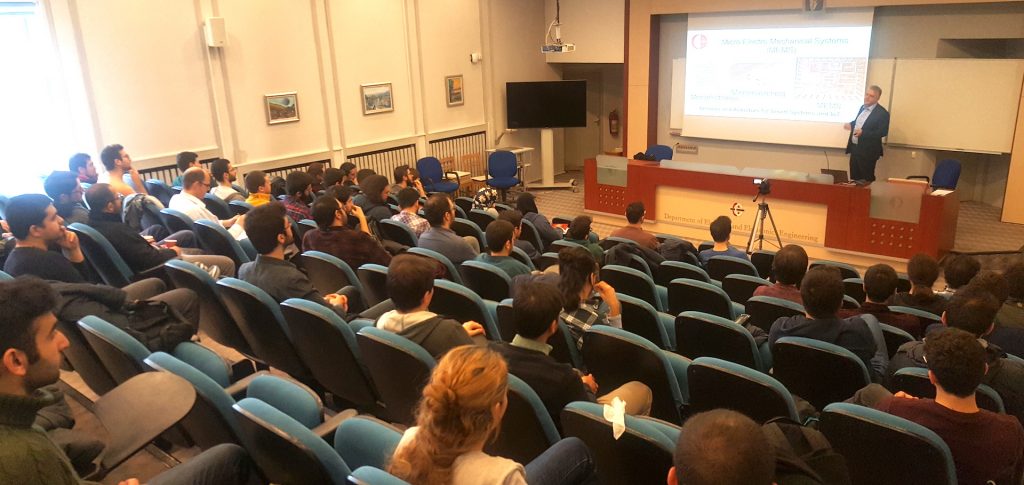
vTools Link: https://events.vtools.ieee.org/m/169620
—
16 February 2018 (13:40): IEEE AP/MTT/EMC/ED Turkey Seminar Series (S.23)
Speaker: Assoc. Prof. Hakan Bağcı, KAUST
Topic: “Time Marching Schemes for Solving Integral Equations of Electromagnetics”
Location: Middle East Technical University, Ankara, Turkey
Abstract: Electromagnetic devices and systems are at the heart of technological advances driving and changing many areas of science and engineering including efficient energy management, biomedical electronics, communications and computing, and even environmental monitoring and civil design. The common denominator of these systems is that they are electrically large, have a wide dynamic range of frequency of operation, their device components are geometrically intricate with dimensions varying by orders of magnitude, and finally their designs require many repetitions of characterizations with different parameters.
The research field of computational electromagnetics enables accurate, efficient, and robust numerical modeling and characterization of such systems. This is a challenging task because the common characteristics listed above translate into large matrix systems with millions (if not billions) of unknowns to be solved for, multi-scale discretizations, and ill-conditioned equations followed by prohibitively long executions times.
This presentation will focus on stable, efficient, and accurate time marching schemes developed to address some of these challenges. More specifically, I will describe (i) an explicit marching-on-in-time (MOT) scheme for solving time domain integral equations (TDIEs), which avoids inversion of dense matrices for increased efficiency and (ii) an MOT-TDIE solver for simulating electromagnetic interactions on high-contrast scatterers, which makes use of a carefully designed extrapolation scheme for increased stability. Numerical experiments, which demonstrate accuracy, efficiency, and applicability of these methods, will also be presented.
Bio: Hakan Bagci received the B.S. degree in Electrical and Electronics Engineering from the Bilkent University, Ankara, Turkey, in 2001; and the M.S. and Ph.D. degrees in Electrical and Computer Engineering from the University of Illinois at Urbana- Champaign (UIUC), Urbana, IL, USA, in 2003 and 2007, respectively.
From June 1999 to July 2001, he worked as an Undergraduate Researcher with the Computational Electromagnetics Group, Bilkent University. From August 2001 to December 2006, he was a Research Assistant with the Center for Computational Electromagnetics and Electromagnetics Laboratory, UIUC. From January 2007 to August 2009, he was a Research Fellow with the Radiation Laboratory, University of Michigan, Ann Arbor, MI, USA. Since August 2009, he has been with the King Abdullah University of Science and Technology (KAUST), Thuwal, Saudi Arabia, where he is currently an Associate Professor of Electrical Engineering.
His research interests include various aspects of theoretical and applied computational electromagnetics with emphasis on well-conditioned frequency and time domain integral equation formulations and their discretization, hybrid time domain integral and differential equation solvers, accurate, stable, and efficient marching schemes for time domain solvers, stochastic characterization of electromagnetic field and wave interactions on complex geometries, and solution of two and three dimensional electromagnetic inverse scattering problem using signal processing techniques. He authored or co-authored 85 journal papers and 180 papers in conference proceedings.
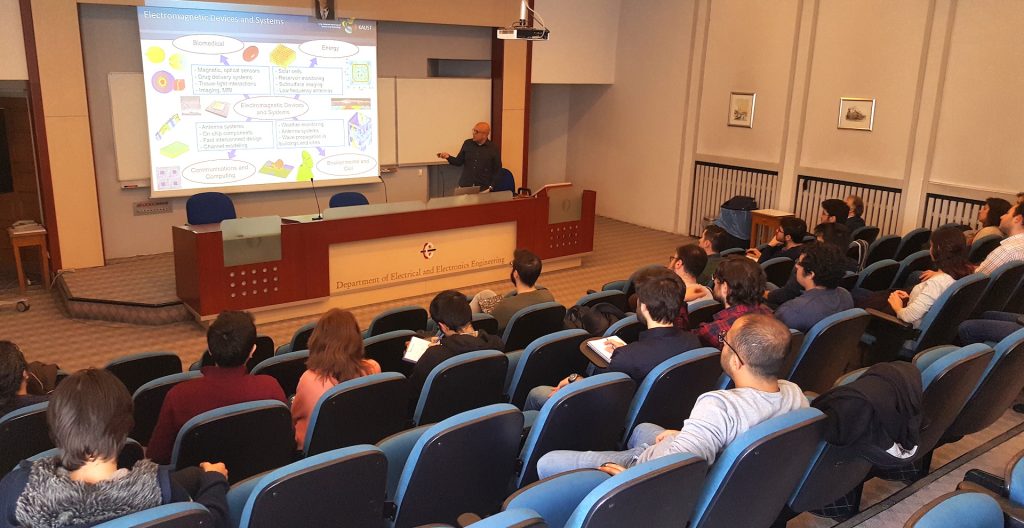
vTools Link: https://events.vtools.ieee.org/m/162914
—
05 January 2018 (13:40): IEEE AP/MTT/EMC/ED Turkey Seminar Series (S.22)
Speaker: Prof. Ekmel Özbay, Nanotechnology Research Center, Bilkent University
Topic: “Metamaterial based nanobiosensors and nanophotodetectors”
Location: Middle East Technical University, Ankara, Turkey
Abstract: In this talk, we will present how metamaterials can be used for nanobiosensors and nanophotodetector applications. Our results show that a plasmonic structure can be successfully applied to bio-sensing applications and extended to the detection of specific bacteria species. A highly tunable design for obtaining double resonance substrates to be used in Surface Enhanced Raman Spectroscopy will also be presented. Surface Enhanced Raman Scattering experiments are conducted to compare the enhancements obtained from double resonance substrates to those obtained from single resonance gold truncated nano-cones. We will present a UV plasmonic antenna integrated metal semiconductor metal (MSM) photodetector based on GaN. We also report the design, fabrication, and measurement of a device comprising a split ring resonator array on epitaxial graphene. We obtained resonance broadening and tuning of split ring resonators by utilizing an epitaxial graphene transistor with transparent top-gate. Metallic split ring resonator (SRR) structures are used in nanophotonics applications in order to localize and enhance incident electromagnetic field. Electrically controllable sheet carrier concentration of graphene provides a platform where the resonance of the SRRs fabricated on graphene can be tuned. The reflectivity spectra of SRR arrays shift by applying gate voltage, which modulates the sheet carrier concentration, and thereby the optical conductivity of monolayer graphene. We experimentally and numerically demonstrated that the tuning range can be increased by tailoring the effective mode area of the SRR and enhancing the interaction with graphene.
Bio: Prof. Dr. Ekmel Ozbay received M.S. and Ph. D. degrees from Stanford University in electrical engineering, in 1989 and 1992. He worked as a postdoctoral research associate in Stanford University and he worked as a scientist in Iowa State University. He joined Bilkent University (Ankara, Turkey) in 1995, where he is currently a full professor in Physics Department and EEE Department. In 2003, he founded Bilkent University Nanotechnology Research Center (NANOTAM) where he leads a research group working on nanophotonics, nanometamaterials, nanoelectronics, GaN/AlGaN MOCVD growth, and GaN based devices. He is the 1997 recipient of the Adolph Lomb Medal of OSA and 2005 European Union Descartes Science award. He worked as an editor for Nature Scientific Reports, Optics Letters, PNFA, and IEEE JQE journals. He has published 430+ articles in SCI journals. His papers have received 13500+ SCI citations with an SCI h-index of 55. He has given 145+ invited talks in international conferences. He recently became the CEO of a spin-off company: AB-MicroNano Inc.
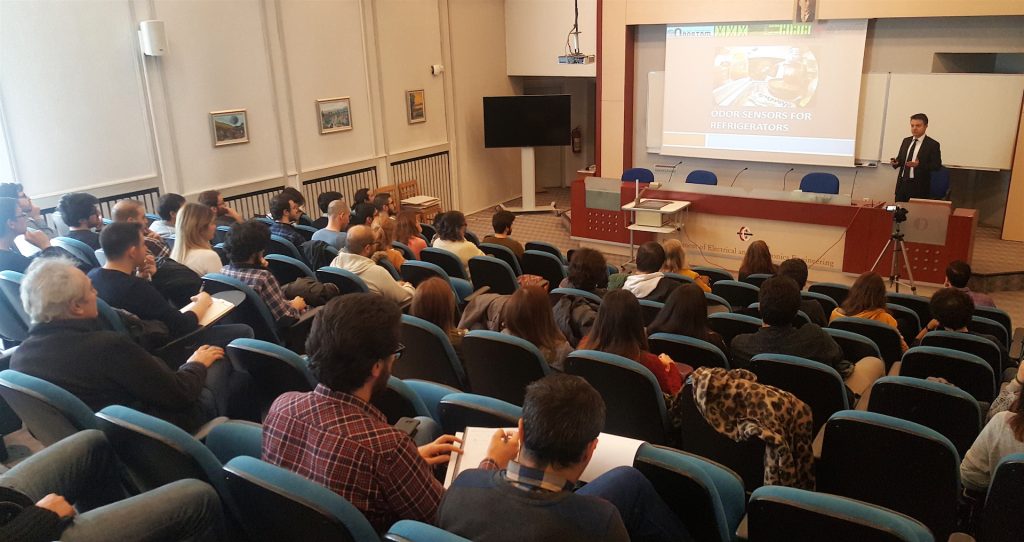
vTools Link: https://events.vtools.ieee.org/m/157225